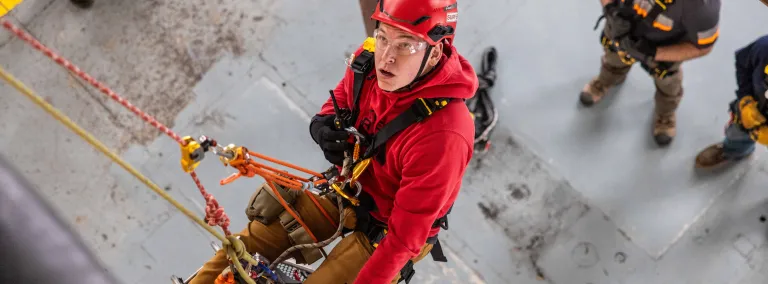New Climbing Tower Helps SURF Emergency Response Teams Hone Shaft Rescue Skills
The Emergency Response Team at SURF requires extensive training in scenarios that resemble the real world.
As the deepest laboratory in the United States, the Sanford Underground Research Facility (SURF) maintains two former mine shafts, the Yates and the Ross. Each shaft drops about a mile down into the earth. Personnel and equipment are transported from the surface to the deep underground laboratory space inside what’s called a cage. It’s basically a large steel box with similar safety mechanisms to an elevator. In the unlikely event that a cage gets stuck inside the shaft, trained rescue crews are on hand at SURF to enter the shaft and pull anyone out to safety.
Imagine being suspended thousands of feet underground and tasked to rescue trapped individuals inside a pitch-black former mine shaft. Crews who do this sort of work require extensive real-world training. For this reason, SURF constructed a unique climbing and rappelling tower meticulously designed to resemble the shafts. One side of the tower is made up of the same types of timber that lines the inside of the Yates Shaft, the other uses the same steel structure and frame found inside the Ross Shaft. This allows emergency response team members to simulate rescue training in either structure.
Barry Van Sickle leads SURF’s Emergency Rescue Team (ERT) which includes 15 certified rope technicians. He says continuous training is vital. This new structure provides a unique opportunity for crews to troubleshoot and simulate rescue operations in a controlled setting. From navigating tight spaces underground to perfecting vertical maneuvers, every aspect of the training is tailored to mimic real-world scenarios.
“We train to secure that cage in place, with chains and wedges, so it can’t move when we are on it to rescue anyone inside,” says Van Sickle. “Then we train to cut a hole in the side of the lacing or timber of an inner shaft and then cut into the steel cage using either chainsaws or battery-operated chop saws—so we can access the cage for that rescue.”
A vital part of the training is working out the logistics of safely using a chainsaw, or chop saw while suspended on a set of ropes over a mile-deep shaft. Another aspect of the training involves moving an injured person onto a stretcher, and then hauling that stretcher up the vertical shaft to the nearest point of safety.
“It's invaluable to make you think through all those little steps of what you're going to need. When you get down there, there are so many procedures you're going to have to follow to affect that rescue work,” says Van Sickle. For example, a rope technician may need to access and start a chainsaw, but only after securing themselves and their own harness and footing inside the shaft.
This type of rope rescue involves a lot of redundancy. The technician and the person being rescued are each on redundant systems. There are safety systems and trained personnel that back up other safety systems and personnel.
The SURF ERT team includes 35 members in total with 15 certified in rope rescue, many of these team members volunteer for the ERT on top of their normal work duties.
“A majority of those volunteers also work here at SURF as their fulltime job,” said Julie Ewing, director of Environment Health and Safety at SURF. “Our volunteers and our fulltime team members are very, very, good at rope rescue. Still, they all will tell you they need ongoing practice. So, being able to have a structure like this new tower to practice has really been positive for our response teams.”
One of the rope rescue volunteers is Dakota VanDerVliet. During his days off work, he frequently comes to train on the new tower with others on the team. To qualify for the rope rescue team, members take special off-site certified rope rescue training at a facility in Utah. Even with all the training under his belt, VanDerVliet says ongoing routine practice in the unique setting at SURF is essential.
“We are leaps and bounds ahead of where we were even a few years ago, there is a real peace of mind in that. We have the people and equipment to do any rescue at SURF,” VanDerVliet said.
SURF’s prioritization of safety is reflected in an excellent track record. The facility recently surpassed a million hour workplace safety milestone. Individuals at SURF may find additional peace of mind knowing the safety culture at the facility includes maintaining a highly skilled rescue team with ample opportunities to simulate real-world training scenarios.
